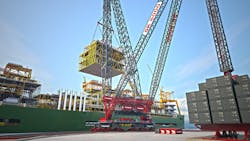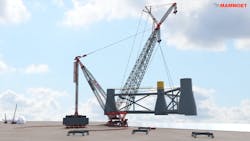Lifting smarter to support growing FPSO and FLNG sizes
By Gavin Kerr, Mammoet
The drive to construct bigger FPSO and FLNG facilities is essential to improve productivity, with superior efficiency benefits to be gained compared to smaller assets. But this trend is not without challenges, including whether there is the correct construction equipment and methodologies to achieve what has been designed.
Modularized construction methods are well proven for FPSO and FLNG projects. Fewer individual components to lift means less time and fewer resources needed for connecting and testing. This reduces cost and can help minimize the construction program, meaning the asset can be deployed faster and is thus productive sooner than may otherwise have been possible.
However, as the size and scale of projects has increased, so has the complexity of delivering a successful modularized build. One barrier here is the size and capabilities of current crane equipment available to lift modules, which can often weigh thousands of tonnes. Whilst larger water-based cranes can be used, these are few and far between, so there is generally a greater reliance on land-based equipment. In these scenarios the maximum lifting capacity of the crane used has a direct impact on the extent to which the topside facility can be modularized, because this lifting capacity dictates the maximum possible module weight.
Currently, the FPSOs go to where the lift capacity is, but if we provide mobile lift capacity, then the FPSO can essentially be built anywhere. This is a key message since Asia almost has a monopoly.
Without the right crane available, a weight limitation is effectively imposed on the design of projects—in turn limiting the ability to build bigger, more productive FPSO and FLNG facilities, as well as how often a crane needs to be relocated and moved around site to complete lifts.
This problem has reached an almost critical level now. It is to the point where the growth in topside capacity now outpaces growth in land-based lifting capability. Whereas previously crane capacity has kept pace with some of the world’s most challenging topside integrations, such as the P-63 and P-76 builds in Brazil and the EGINA project in Nigeria, this is no longer the case.
Therefore, a new generation of cranes is needed to address the current bottleneck in modularization scale and efficiency—not only in terms of the sheer size of lifts possible but also the distance from which modules can be lifted and put into place.
Lifting technology provides more options
Meeting these demands is precisely what companies like Mammoet have sought to do in developing cranes with lifting power far greater than that which was previously available. In the instance of the SK6000, this means unprecedented lifting power of up to 6,000 t with an outreach of up to 160 m with the main mast, and 3,000 t with an outreach of up to 220 m with the jib attachment.
Whereas previously FPSO and FLNG projects were limited to lifts of about 3,000 t, the availability of larger cranes means there is now the potential to go to 6,000 t, which can have a profound impact on the timescale of projects. Connecting, for example, two modules rather than eight means a 400% decrease in connections that must be joined together, and therefore huge savings on integration time and working at height.
Even where modules are lighter, the longer outreach and stronger load moment of larger cranes means greater flexibility in where and how modules are lifted. Modules can be collected from a wider radius around the shipyard than would previously have been possible. This allows more work across site to be done simultaneously, and it prevents the need to dismantle and relocate the crane, which may otherwise happen in extreme cases.
In addition, it also negates the transportation of modules to the hook, which saves time, cost and crucially space since there is no need to create a transport route at the yard. The need to rotate and shift the hull of the facility is also reduced as greater reach and load moment means more options for where modules can be placed from one crane position.
A further benefit is that using a crane that can be shipped and erected at any suitable facility around the world means the choice of yard is no longer restricted by where there is sufficient lifting capacity. Whereas at present FPSO projects will typically have to go where there is a facility with the right sized crane. With equipment such as the SK6000, that lifting capacity can now be brought to the project, potentially opening up more choice in how and where assets are built.
Whereas in recent years the largest FPSO and FLNG projects may have had to limit modular construction to fit the capabilities of available cranes, the SK6000 will ease these limitations. There is now lifting technology that can help to make possible a new scale in modular projects to help drive more efficient energy facilities.
About the author: Gavin Kerr is the director of global cranes with Mammoet.
11.22.2023


